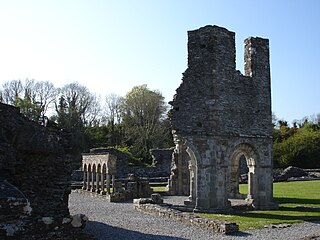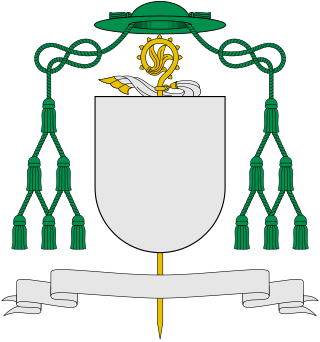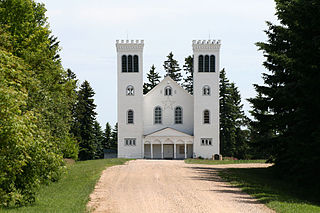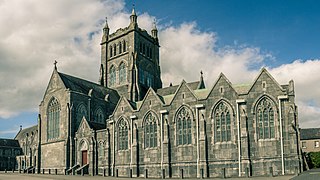Related Research Articles
The Benedictines, officially the Order of Saint Benedict, are a mainly contemplative monastic religious order of the Catholic Church for men and for women who follow the Rule of Saint Benedict. The male religious are also sometimes called the Black Monks, in reference to the colour of their religious habits, in contrast to other Benedictine orders such as the Olivetans, who wear white. They were founded in 529 by Benedict of Nursia, a 6th-century Italian monk who laid the foundations of Benedictine monasticism through the formulation of his Rule. Benedict's sister, Scholastica, possibly his twin, also became a religious from an early age, but chose to live as a hermit. They retained a close relationship until her death.

Buckfast Abbey forms part of an active Benedictine monastery at Buckfast, near Buckfastleigh, Devon, England. Buckfast first became home to an abbey in 1018. The first Benedictine abbey was followed by a Savignac, later Cistercian, abbey constructed on the site of the current abbey in 1134. The monastery was surrendered for dissolution in 1539, with the monastic buildings stripped and left as ruins, before being demolished. The former abbey site was used as a quarry, and later became home to a Gothic mansion house.

The Trappists, officially known as the Order of Cistercians of the Strict Observance and originally named the Order of Reformed Cistercians of Our Lady of La Trappe, are a Catholic religious order of cloistered monastics that branched off from the Cistercians. They follow the Rule of Saint Benedict and have communities of both monks and nuns that are known as Trappists and Trappistines, respectively. They are named after La Trappe Abbey, the monastery from which the movement and religious order originated. The movement first began with the reforms that Abbot Armand Jean le Bouthillier de Rancé introduced in 1664, later leading to the creation of Trappist congregations, and eventually the formal constitution as a separate religious order in 1892.

New Melleray Abbey is a Trappist monastery located near Dubuque, Iowa. The abbey is located about 15 miles southwest of Dubuque and is in the Archdiocese of Dubuque. Currently the Abbey is home to about 16 monks. Several of the monks work in their business, Trappist Caskets, and some of their food comes from the garden behind the Abbey. The abbot of the monastery is Dom Brendan Freeman, who was appointed by Father Immediate McCarthy in December 2021 after consulting the community.

Mellifont Abbey, was a Cistercian abbey located close to Drogheda in County Louth, Ireland. It was the first abbey of the order to be built in Ireland. In 1152, it hosted the Synod of Kells-Mellifont. After its dissolution in 1539, the abbey became a private manor house. This saw the signing of the Treaty of Mellifont in 1603 and served as William of Orange's headquarters in 1690 during the Battle of the Boyne.

Moone is a small village in the south of County Kildare, Ireland. It is on the former N9 road about 80 km (50 mi) south of Dublin. It has only a few hundred inhabitants, a church, a national school, one shop and a small community centre. There is also pub called the Moone High Cross Inn. The village is in a townland and civil parish of the same name.

Downside Abbey is a Benedictine monastery in England and the senior community of the English Benedictine Congregation. Until 2019, the community had close links with Downside School, for the education of children aged eleven to eighteen. Both the abbey and the school are at Stratton-on-the-Fosse, between Westfield and Shepton Mallet in Somerset, South West England. In 2020, the monastic community announced that it would move away from the present monastery and seek a new place to live. In October 2021, the monastic community further announced that as part of their transition they would move in Spring of 2022 to the temporary accommodation of "Southgate House, in the grounds of Buckfast Abbey, Devon, where we will live as the Community of St Gregory the Great". As of 2020, the monastic community of Downside Abbey was home to fifteen monks.

The Abbey of Our Lady, Help of Christians, commonly known as Worth Abbey, is a community of Roman Catholic monks who follow the Rule of St Benedict near Turners Hill village, in West Sussex, England. Founded in 1933, the abbey is part of the English Benedictine Congregation. As of 2020, the monastic community had 21 monks.

Mount St Bernard Abbey is a Trappist monastery near Coalville, Leicestershire, England, founded in 1835 in the parish of Whitwick and now in that of Charley. The abbey was the first permanent monastery to be founded in England since the Reformation and is the sole Trappist house in England. The monks brew the only Trappist beer in Britain.

A territorial abbey is a particular church of the Catholic Church comprising defined territory which is not part of a diocese but surrounds an abbey or monastery whose abbot or superior functions as ordinary for all Catholics and parishes in the territory. Such an abbot is called a territorial abbot or abbot nullius diœceseos. A territorial abbot thus differs from an ordinary abbot, who exercises authority only within the monastery's walls or to monks or canons who have taken their vows there. A territorial abbot is equivalent to a diocesan bishop in Catholic canon law.

Mount St. Joseph Abbey is an abbey of the Trappist branch of the Cistercians located in County Offaly, near Roscrea, County Tipperary in Ireland.

Our Lady of Bethlehem Abbey, a Cistercian monastery in Portglenone, County Antrim, Northern Ireland, was founded in 1948 by the Cistercian community of Mount Melleray Abbey in County Waterford. The monks bought Portglenone House, a country mansion built c. 1810 by the Church of Ireland Bishop, Dr. Alexander who demolished the local castle. History records that Sir Roger Casement often stayed in the house in the early years of the 20th century.

Solesmes Abbey or St. Peter's Abbey, Solesmes is a Benedictine monastery in Solesmes, Sarthe, France, and the source of the restoration of Benedictine monastic life in the country under Dom Prosper Guéranger after the French Revolution. The current abbot is the Right Reverend Dom Abbot Geoffrey Kemlin, O.S.B., elected in 2022.

Nunraw Abbey or Sancta Maria Abbey, Nunraw is a working Trappist monastery. It was the first Cistercian house to be founded in Scotland since the Scottish Reformation. Founded in 1946 by monks from Mount St. Joseph Abbey, Roscrea, Ireland, and consecrated as an Abbey in 1948, it nestles at the foot of the Lammermuir Hills on the southern edge of East Lothian. The estate of the abbey is technically called White Castle after an early hill-fort on the land.

St. Peter's Abbey is in Muenster, Saskatchewan, Canada. It is the oldest Benedictine monastery in Canada. It was founded in 1903.

Prinknash Abbey is a Roman Catholic monastery in the Vale of Gloucester in the Diocese of Clifton, near the village of Cranham. It belongs to the English Province of the Subiaco Cassinese Congregation, which is itself part of the worldwide Benedictine Confederation. It is noted for its manufacturing of incense.

Mount Melleray Abbey is a Trappist monastery in Ireland, founded in 1833. It is situated on the slopes of the Knockmealdown Mountains, near Cappoquin, Diocese of Waterford.
The sexual abuse scandal in the English Benedictine Congregation was a significant episode in the series of Catholic sex abuse cases in the United Kingdom. The dates of the events covered here range from the 1960s to the 2010s.
The Subiaco Cassinese Congregation is an international union of Benedictine houses within the Benedictine Confederation. It developed from the Subiaco Congregation, which was formed in 1867 through the initiative of Dom Pietro Casaretto, O.S.B., as a reform of the way of life of monasteries of the Cassinese Congregation, formed in 1408, toward a stricter contemplative observance, and received final approval in 1872 by Pope Pius IX. After discussions between the two congregations at the start of the 21st century, approval was given by Pope Benedict XVI in 2013 for the incorporation of the Cassinese Congregation into its offshoot, the Subiaco Congregation. The expanded congregation was given this new name.

Koningshoeven Abbey is a monastery of the Trappists founded in 1881 in Berkel-Enschot in North Brabant, the Netherlands.
References
- ↑ Bolton Abbey Ordre Cistercien de la Stricte Observance.
- ↑ Over the moon in moone Kildare Nationalist, 8 September 2015.
- ↑ 'Gregory's Angels: A History of the Abbeys, Priories, Parishes and Schools of the Monks and Nuns' By Gordon Beattie OSB, 1997.
- ↑ Abbot and school president known for his kindness and wisdom - Peter Garvey Irish Times, 13 December 2014.
- ↑ Homily of Archbishop Martin, at the Abbatial Blessing of Dom Michael Ryan, OCSO Catholic Communications Office, 11 July 2012